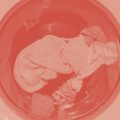After the Leftovers
In its finale, The Leftovers catches us up. Earlier in the season, the series' third, Nora Durst (Carrie Coon), a US fraud investigator, lands in Australia, having been notified of a machine that promises to carry its users to an alternate reality. There, in the alternate reality, users will find the two percent of the world population who vanished in the Sudden Departure of October 14, 2011. Nora seeks not to report the machine's operators but to enter it herself. Doing so might reunite her with her husband and two children, all lost to that fateful event. More likely, it might kill her. We cannot ascertain the operation's success, for the scene that Nora spends inside the capsule cuts abruptly when, metallic fluid up to her neck, she lets out a scream. Meanwhile, Nora's boyfriend Kevin Garvey (Justin Theroux), in Australia to accompany her, gets caught up in a biblical plot. Relatives and friends elect him as their reluctant prophet, believing him able to forestall the rapture. Kevin has died and resurrected before, but whether his messianic talents lend themselves to apocalyptic deferral remains untested. Perhaps thanks to Kevin, perhaps not, the world doesn't end, not any more than it already has.
Kevin flies back to the United States shortly after he and Nora part ways, then devotes his time off to wandering rural Australia in search of her. Twelve, maybe fifteen years later, his pilgrimage reaches its intended conclusion. Nora eventually agrees to fill him in, starting where we last saw her: inside the transmogrifying device. "I didn't change my mind. I went through," she holds. Nora woke up, naked, in a parking lot bearing no traces of people, vehicles, or the machine she had been in. She took "a long time" to travel to the United States by boat. In her hometown of Mapleton, New York, she stood behind a tree and watched her children, her husband, and a woman she couldn't identify; all looked content. "And I was a ghost," Nora contrasts, "I was a ghost who had no place there. And that, Kevin, is when I changed my mind." She located the inventor of the machine and asked him to build another. The rest of the tale is compressed: "I told him it's because I didn't belong there. So, he built it. And I came back through. I came back here. Did I... think about you? Did I want to call you? Did I want to be with you, Kevin? Of course, I did. But so much time had passed. It was too late. And I knew that if I told you what happened... that you would never believe me." Kevin differs, "I believe you." "You do?" "Why wouldn't I believe you?" he reasons, "You're here."
Nora and Kevin smile, hold hands, shed a few tears. As they relax, so, too, does the camera. The conversation's strained closeups give way to an exterior shot of Nora's house against a spectacular sunset. Her birds, missing since the previous evening, flock to their coop. The ending is, in many ways, happy. The house has turned into a home. Two characters who didn't belong now do. Their unlikely reunion has given credence to unlikely explanations, the "tell, don't show" principle discriminating against no causes. Nora and Kevin, dwellers in the posttraumatic, appear to have accepted that narratives owe their truth not to their verisimilitude but to their ability to organize the disorganized. Still, for all of the repair of copresence and the satisfaction of narrative, there is at least one way that the ending counts as tragic. The finale repeats what prior episodes have made abundantly clear: being here isn't the solution, it's the problem. Being here means having been leftover.
***
Another character we had reason to believe had died returns in the finale: Kevin's ex-wife Laurie (Amy Brenneman). We last spotted Laurie somewhere in the Bass Strait, a couple of episodes earlier. She dove backward, scuba gear on her back, following a sweetly boisterous phone exchange with her two children, Jill (Margaret Qualley) and Tommy (Chris Zylka). Before then, Nora had told Laurie, with the neighborliness of someone with a lifehack to spare, that scuba diving guaranteed ideal conditions for suicide, insofar as the air hose could twist without bearing evidence of intent. Laurie's observation, in the same conversation, that "we're all gone" had left little room for equivocation. The finale, however, confirms that Laurie has resurfaced and been serving as Nora's long-distance therapist. Laurie's survival compounds the spectatorial relation to recurring characters with the conflicting experience of loving the suicidal. Should we feel relieved when those who deem themselves already "gone" show up? Should we expect others to stay alive for us? Is that fair?
Laurie had called off a suicide plot before. Not long after the Sudden Departure, she had ingested a handful of pills, then regurgitated them, opting instead to join the Guilty Remnants (GR), the cult around which much of the first season revolves. Laurie would later endeavor to rid herself and others of the GR's beliefs, but her remark that "we're all gone" would prove them recalcitrant. The series doesn't dwell on the GR's theology; the source material, a novel by Tom Perrota, reveals slightly more. For the GR, the Sudden Departure did, in fact, mark the end of the world. Members fashion themselves as "living reminders": zealously Badiouan subjects who maintain "evental fidelity" to the disruption and the new universal it inaugurates.1 The pilot culminates with the GR's disturbance of a commemorative gathering at which Nora, a self-appointed spokesperson for the acutely grieving, is giving a speech. The GR raise signs that, once aligned, spell out, "STOP WASTING YOUR BREATH." They promote, rather than a life of grief, a practice of dying.
Members of the GR reside in communes, dress in white, observe a silence vow, and chain-smoke cigarettes. Their smoking inverts an anecdote in Barbara Johnson's Persons and Things.2 As a child, Johnson could not eat anything with a face. Not anything that had had a face — her diet was not an incipient vegetarianism—but anything that bore the representation of a face, a face that retained its smile even as it was being consumed. Whereas Johnson refused to consume anything indifferent to its own death, the GR seek to consume death itself in order to give it a face. In breathing, as I've written elsewhere, life and death, vitality and morbidity, cure and poison do not stand in binary opposition.3 The GR hope to overcome this fact by saturating every breath with toxicity, and toxicity alone. As they smoke, members process, and thus personify, a world already gone.
In second and third seasons that move beyond the events depicted in Perrota's novel, The Leftovers follows Laurie's lead in attempting to free itself from the Guilty Remnants. The show leaves Mapleton, set ablaze in a standoff between the GR and their opponents, when Nora and Kevin relocate to Jarden, Texas. No one departed from Jarden on October 14, 2011, hence its nickname, Miracle. Jarden's perimeter is heavily policed. When the GR infiltrate it, retaliation follows: a military drone obliterates the cult's encampment on the outskirts of the gated community. Neither the relocation nor the retaliation keeps the GR at bay. Kevin, a cop, remains haunted by the ghost of Patti (Ann Dowd), a GR member he tortured. Moreover, when the GR exit the frame, the narrative structure begins to mimic their practice of self-negation. The show returns again and again to traumatic scenes. The plot skips and resets, like a bike chain out of alignment.
An example. The season 2 opener ends with an earthquake and the — unrelated, it turns out — disappearance of Evie (Jasmin Savoy Brown), a teenage neighbor of Nora and Kevin in Jarden. Instead of picking up where the first episode left off, the second retraces our protagonists' arrival in Jarden. Nora sold her house and collected more than four times its value because researchers were eager to investigate the property, suspecting that geophysical factors were to blame for the disappearance of her husband and children. Other researchers later posit, more creatively, that Nora herself is a "lens," an ancient demon having taken possession of her body and caused her loved ones to depart. The second episode concludes in the immediate aftermath of the earthquake: Kevin wakes up at the bottom of an empty spring, the water siphoned by a giant fissure. The third episode goes back in time yet again. Laurie, who has just escaped the GR, works in tandem with her son Tommy to spot vulnerable cult members, persuade them to quit, and guide them through their recovery. While pitching her GR tell-all to eager editors, Laurie learns that one woman who had returned to her family after her rehabilitation deliberately drove in the wrong highway lane, killing herself, her husband, and their child. By the end of the third episode, the timeline of the first still hasn't been exceeded. With each reset comes whiplash.
Another example. All three seasons of The Leftovers begin with parables laying out situations beyond which characters cannot move. Season 1 opens on the day of the Sudden Departure. A character identified as "Sam's mother" in the credits (Natalie Gold) is about to drive out of a grocery store parking lot. A few seconds after her toddler stops crying, she realizes that he no longer is in the backseat. A grocery cart crashes into another car, and panic ensues. Sam's mother reappears periodically throughout the show. Just as Sam's mother gets defined by her loss, indeed becomes her loss, the show, despite its many twists and turns, continues to loop back to the Sudden Departure.
The other two prologues are more properly allegorical. In the second season's prehistoric opening, a pregnant person narrowly avoids death by exiting a cave before rocks collapse and block the aperture. After she gives birth, a snake bites and kills her. Another individual rescues the newborn, echoing the season 1 finale, in which Nora adopts a baby she finds on Kevin's stoop. The camera pans to reveal that the spring around which the prehistoric vignette has taken place is located in present-day Jarden. It is the spring that inexplicably drains when Kevin attempts to drown himself. Kevin has no recollection of this event until the ghost of Patti brings it up with characteristic pragmatism: "Let's face it, Kevin. There are people who try to commit suicide for attention. And then, there are people who really want to fucking die, like me and you. I watched you do it, and you did not hesitate, my friend. And if not for an act of divine intervention, you'd be gone." Divine interventions multiply and become mundane. Even when Kevin does die, he resurrects — more than a few times. Following visits to the underworld that play out as surreal sequences — one in which he transforms into an "international assassin," the other in which he does double duty as the US president and his identical twin brother — he wakes up. Kevin can't die, or stay dead.
The final season's wordless parable is set in a less distant past. In the nineteenth century, Millerites interpret the Book of Revelation to predict the Second Coming of the Christ. On the presumed day of the Second Coming, a woman, a man, and their child dress in white and stand on a roof, ready to ascend. At sunrise, they go down the ladder, defeated. Recalculation leads to a new prediction, and the pageantry is back on. Still nothing. The woman remains a fervent believer, but her husband and child grow distant. Larry Norman's "I Wish We'd All Been Ready," which plays throughout the prologue's first half, ends with a repetition of the line, "You've been left behind." Following a few seconds of silence, a variation on Max Richter's "Departure" theme comes on, just as it did in the first two prologues. Here we are again, the musical theme's return reinforces. We've been left behind.
The Leftovers' suicide plots, whether they are thwarted or woven into the very autopoiesis of respiration, appear to complicate, as does Dana Seitler, suicidality's movement toward closure, or the equivalence between "the end of life" and "the end of the story."4 Yet the series also frustrates the recuperative momentum of Seitler's argument. "Read nontragically," Seitler offers, "the suicide plot instructs us on the significance of narrative nonclosure as not only a formal technique but an ethical practice, one in which morally charged notions of personhood, as well as biopolitical forces of the management of life, are suspended by the queer energies of its non-telos."5 But tragedy in The Leftovers lies precisely in nonclosure. The "energies" — a term also used by Lauren Berlant in their own writing on "suicidiation" — of being here qua being leftover, whatever they may be, are not available to a project of "recomposing the world."6
***
Juan-David Nasio proposes an overall optimistic spin on the psychoanalysis of repetition-compulsion. I also cite it, though not at such great length, in another piece on similar themes — a piece to which the present essay constitutes a companion of sorts.7 Operating from the premise that "the unconscious is repetition," Nasio asks, then answers,
But what does it mean to persist in one's being, if not to repeat and to repeat in order to conserve one's unity as an individual, to fulfill oneself — that is to say to exist to the fullest possible extent—and to reinforce one's identity in the passage of time? I repeat myself, and by repeating myself, I conserve my past because by rediscovering it each time I appropriate it; I improve myself because with each repetition, learning from experience, I gain knowledge, I learn to contextualize experience, and, in the end I consolidate my identity. Since I am forced to repeat, I conform that I am the same today and tomorrow. In sum, I repeat, therefore I am. What then is the purpose of repetition? In fact, repetition does not have an external goal that it seeks to attain. It is essentially an irreducible tendency that has no other purpose than to remain a force that leads us to better ourselves. ... Repetition structures us, reassures us, and enhances our well-being.8
The compulsion to repeat trauma in The Leftovers doesn't "enhance" the characters' "well-being," as Nasio's existentially inflected account expects it would. "Being here," it bears repeating, plays out as a tragedy. This isn't to say that the series is devoid of humor; it is one of the more reliably funny in recent memory. Yet we have little reason to believe that being here might equal being well, or that it might be possible, through means other than disavowal, to be here without also being gone.
A portion of Nasio's account rings truer in the context of The Leftovers: that which pertains to repetition's structuring and reassuring function. What are monikers like "Sam's mother" or "Guilty Remnant" if not the consolidation into identities of the experience of having been left behind? Whereas the episodic resets of animated comedies carry the promise of a clean biographical slate, drawbacks in The Leftovers force characters to keep carrying a damage they have nowhere to store. Not even hopping between Mapleton, Jarden, and Australia grants them enough distance to mourn the departed. Whereas James R. Martel detects in the Sudden Departure "an existential threat to archism," his term for "a form of politics based on rule and hierarchy," I see, less optimistically, something like a life sentence: characters are condemned to a life that repeats, but never moves beyond, the loss of a relational or social status quo.9 Characters exist only as the living, breathing relics of a ruptured and raptured world. They become symptoms.
We, too, are symptoms of a broken world, The Leftovers insists, all the while refraining from analogizing the Sudden Departure to any of the extinction events through which we are living. Spectators are implicated by the characters' repetition compulsion, and not just because of the loopy narrative structure. The songs that supplement Richter's score, itself remarkably loopy, address us. In addition to Norman's aforementioned reminder that we've "been left behind," let's note the imperative to "let the mystery be" in Iris DeMent's song of the same name. DeMent's song plays through the season 2 opening titles, urging irresolution. "You're here," such addresses tell us. We're here, and we're confronted with the unfixable problem that is our compulsion to pantomime the world's brokenness.
Jean-Thomas Tremblay is Associate Professor of Environmental Humanities and Director of the Graduate Program in Social and Political Thought at York University, in Toronto. He is the author of Breathing Aesthetics (Duke University Press, 2022) and, with Steven Swarbrick, a co-author of Negative Life: The Cinema of Extinction (Northwestern University Press, 2024).
References
- Alain Badiou, Saint Paul: The Foundations of Universalism, trans. Ray Brassier (Stanford: Stanford University Press, 2003), 90.[⤒]
- Barbara Johnson, Persons and Things (Cambridge: Harvard University Press, 2008), 4. See also Sianne Ngai, Theory of the Gimmick: Aesthetic Judgment and Capitalist Form (Cambridge: Belknap Press of Harvard University Press, 2020), 174-175.[⤒]
- Jean-Thomas Tremblay, Breathing Aesthetics (Durham: Duke University Press, 2022).[⤒]
- Dana Seitler, "Suicidal Tendencies: Notes toward a Queer Narratology," GLQ 25, no. 4 (2019): 607.[⤒]
- Seitler, "Suicidal Tendencies," 614.[⤒]
- Lauren Berlant, On the Inconvenience of Other People (Durham: Duke University Press, 2022), 123, 124.[⤒]
- Jean-Thomas Tremblay, "Basically the Same: Todd Haynes's May December," differences: A Journal of Feminist Cultural Studies, December 20, 2023.[⤒]
- Juan-David Nasio, Psychoanalysis and Repetition: Why Do We Keep Making the Same Mistakes?, trans. David Pettigrew (Albany: State University of New York Press, 2019), 1, 14-15.[⤒]
- James R. Martel, Anarchist Prophets: Disappointing Vision and the Power of Collective Sight (Durham: Duke University Press, 2022), 243, 1.[⤒]










